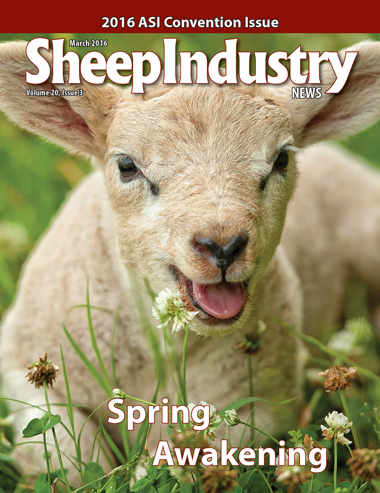
- March 2016
- President’s Notes
- 2016 ASI Convention
- The Strength of a United Voice
- State Execs Benefit from Media Training
- Award Winners Recognized
- Producer Panel Praises EBVs
- PERC Hears Survey Results
- Tips on Preparing for VFD
- Providing Consistent, Quality Lamb
- Let’s Grow Sets New Priorities
- Allotment Records Are Important
- Legislative Council Busy in 2015
- Next Generation Makes Plans
- Arizona Ag Tour
- Optimism For Wool Industry
- Make It With Wool Winners
- Working Dog Liability Insurance
- Seeking Young Producer for Tri-Lamb
- Wolf Testifies on Behalf of Sheep
- Sheep Inventory Up Again
- Use NSIP Data To Improve Lambing Rates
- Market Report
Allotment Records Are Important
CAT URBIGKIT
Special to the Sheep Industry News
If your domestic sheep flocks graze on public lands in the West, do you know what is in agency files for your allotments or grazing permits? If an agency representative picks up the file and has a look, will there be little more than notes and photos of problem or potential problem areas?
Idaho attorney Billie Siddoway advised during the Resource Management Council meeting that permittees should get to know the administrative record for their allotments, and make sure that record provides an accurate reflection of its condition. This is especially important for permittees grazing domestic sheep in or near bighorn sheep range, as the U.S. Forest Service prepares its “risk of contact” analyses that will be used to decide the future of livestock grazing near bighorns.
Siddoway said her Idaho sheep-ranching family asked to see their allotment record and found it contained mostly negative information that didn’t show the overall condition of the allotment, or important information about how it is used.
Her family now provides a variety of information to the U.S. Forest Service for inclusion in the record – from photos taken during the grazing season, to notes transcribing end-of-season interviews with herders. Among other things, herders are asked if they witnessed bighorn/domestic sheep interactions on the range, and their answers are recorded and placed into the record for the allotment.
Siddoway has used the Freedom of Information Act to find out more information that is important for her family’s allotments. Information can be obtained from state wildlife agencies (such as bighorn sheep tracking and foray information), as well as the state veterinarian and department of agriculture and other federal and state agencies. Producers should seek out this information and make sure pertinent details are supplied to the Forest Service for inclusion in the allotment record.
Siddoway offered up this “To do list” for permittees:
• Put together a timeline. Is there a schedule for forest plan revision, permit renewals or other planning deadlines (including analyses promised as part of settlement agreements)?
When the Forest Service undertakes any of these processes, the agency will analyze bighorn/domestic sheep conflicts, so knowing the timeline will help develop a plan for supplementing allotment records.
• Get the facts. Find out what is in your permit files, and use the Freedom of Information Act to acquire more detailed information and data.
Acquire data from other agencies and find out what “inputs” are being used for your risk of contact analysis, and if mountain goat presence has been considered as well, since this species is also considered a threat for disease transmission.
• Get your allotment record in order. Be sure that you provide information to the agency that reflects the condition of the allotment.
Since federal agencies are required to use the best available science in decision-making, go to the experts for that information and get it placed in your record.
When it comes to bighorn sheep disease, Dr. Don Knowles, USDA’s Animal Diseases Research Leader, and his research colleague, Dr. Maggie Highland (both of Washington State University), should be consulted.

